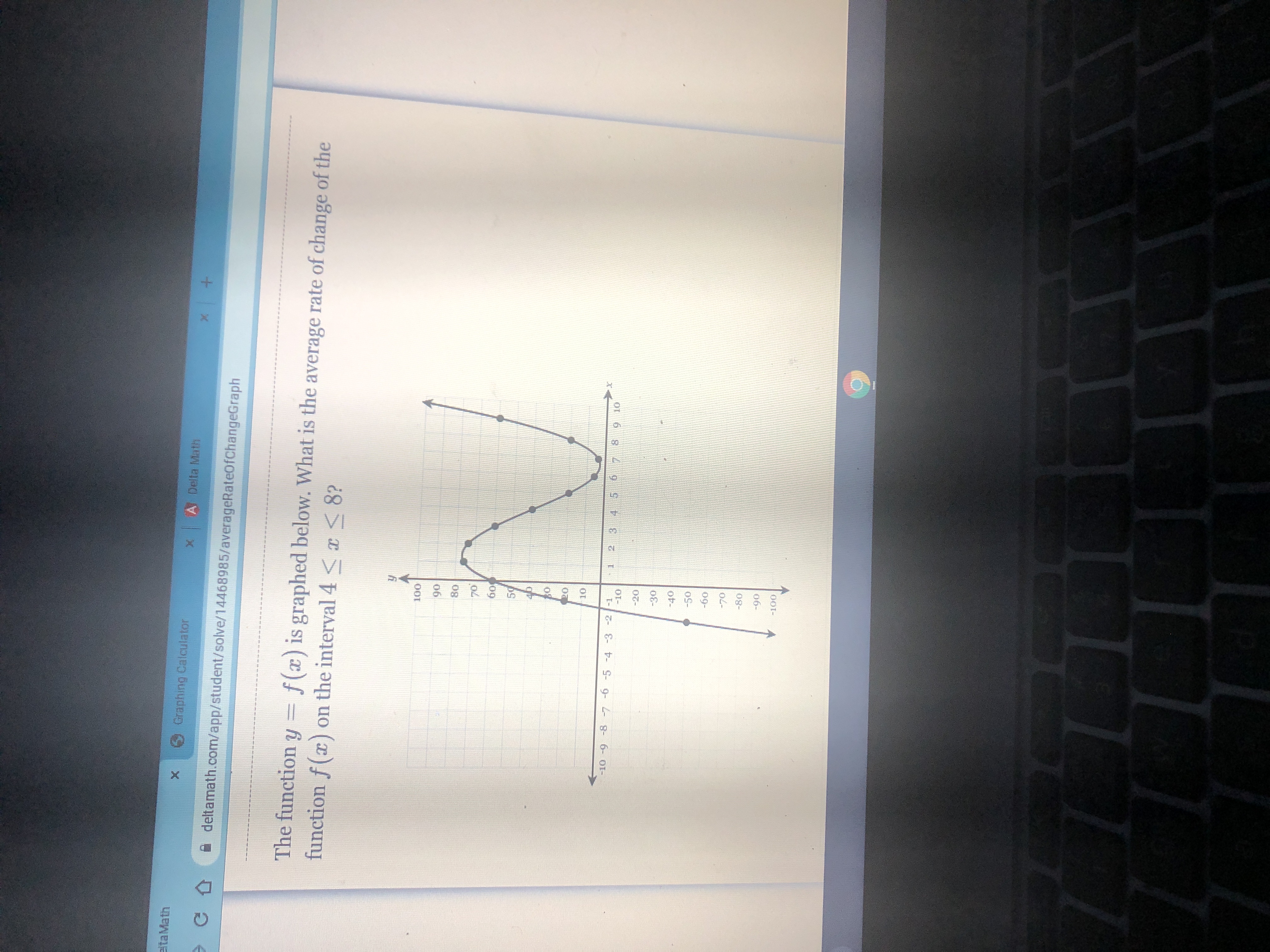
Calculus: Early Transcendentals
8th Edition
ISBN: 9781285741550
Author: James Stewart
Publisher: Cengage Learning
expand_more
expand_more
format_list_bulleted
Question

Transcribed Image Text:+ x
A Delta Math
Graphing Calculator
The function y = f(x) is graphed below. What is the average rate of change of the
function f (x) on the interval 4 sI< 8?
eltaMath
A deltamath.com/app/student/solve/14468985/averageRateOfChangeGraph
06
OF
78 9 10
7- - 6- 9- L- g- 6- 01-
-30
0S-
09-
0L-
06-
Expert Solution
This question has been solved!
Explore an expertly crafted, step-by-step solution for a thorough understanding of key concepts.
This is a popular solution
Trending nowThis is a popular solution!
Step by stepSolved in 2 steps with 1 images

Knowledge Booster
Similar questions
- HELP PLEASEarrow_forwardFind a positive two digit number such that the sun of the number and it's reciprocal is as small as possible. Include let statements, a detailed diagram, an algebraic function, state interval, derivative function and equations, absolute min/max values (x,y), end of the interval tests, final answer statement.arrow_forwardHow to find the slope for hx=4x+3 on the subject of math precalculus 1arrow_forward
- Choose the graph of a function having the given properties. From x 0 to x 10 the function increases and the slope decreases. When x> 10 the fu Type here to searcharrow_forwardSelect the statement that is false about the difference quotient. The difference quotient can be represented by f(x+h)−f(x)(x+h)−x or f(x+h)−f(x)h The difference quotient is a more general form of the average rate of change of a function on an interval h units long. The difference quotient describes the general behavior of a function over some interval h units long when the rate of change is not constant. As the value of h gets smaller and smaller, the value of the difference quotient becomes a better and better approximation of the average rate of change of a function f near (x,f(x)). As the value of h gets larger and larger, the value of the difference quotient becomes a better and better approximation of the average rate of change of a function f near (x,f(x)).arrow_forwardri File Edit View History Bookmarks Window Help く > F9 F1 F2 F5 F6 F8 4, 3. 2. 3.arrow_forward
arrow_back_ios
arrow_forward_ios
Recommended textbooks for you
 Calculus: Early TranscendentalsCalculusISBN:9781285741550Author:James StewartPublisher:Cengage Learning
Calculus: Early TranscendentalsCalculusISBN:9781285741550Author:James StewartPublisher:Cengage Learning Thomas' Calculus (14th Edition)CalculusISBN:9780134438986Author:Joel R. Hass, Christopher E. Heil, Maurice D. WeirPublisher:PEARSON
Thomas' Calculus (14th Edition)CalculusISBN:9780134438986Author:Joel R. Hass, Christopher E. Heil, Maurice D. WeirPublisher:PEARSON Calculus: Early Transcendentals (3rd Edition)CalculusISBN:9780134763644Author:William L. Briggs, Lyle Cochran, Bernard Gillett, Eric SchulzPublisher:PEARSON
Calculus: Early Transcendentals (3rd Edition)CalculusISBN:9780134763644Author:William L. Briggs, Lyle Cochran, Bernard Gillett, Eric SchulzPublisher:PEARSON Calculus: Early TranscendentalsCalculusISBN:9781319050740Author:Jon Rogawski, Colin Adams, Robert FranzosaPublisher:W. H. Freeman
Calculus: Early TranscendentalsCalculusISBN:9781319050740Author:Jon Rogawski, Colin Adams, Robert FranzosaPublisher:W. H. Freeman
 Calculus: Early Transcendental FunctionsCalculusISBN:9781337552516Author:Ron Larson, Bruce H. EdwardsPublisher:Cengage Learning
Calculus: Early Transcendental FunctionsCalculusISBN:9781337552516Author:Ron Larson, Bruce H. EdwardsPublisher:Cengage Learning

Calculus: Early Transcendentals
Calculus
ISBN:9781285741550
Author:James Stewart
Publisher:Cengage Learning

Thomas' Calculus (14th Edition)
Calculus
ISBN:9780134438986
Author:Joel R. Hass, Christopher E. Heil, Maurice D. Weir
Publisher:PEARSON

Calculus: Early Transcendentals (3rd Edition)
Calculus
ISBN:9780134763644
Author:William L. Briggs, Lyle Cochran, Bernard Gillett, Eric Schulz
Publisher:PEARSON

Calculus: Early Transcendentals
Calculus
ISBN:9781319050740
Author:Jon Rogawski, Colin Adams, Robert Franzosa
Publisher:W. H. Freeman


Calculus: Early Transcendental Functions
Calculus
ISBN:9781337552516
Author:Ron Larson, Bruce H. Edwards
Publisher:Cengage Learning